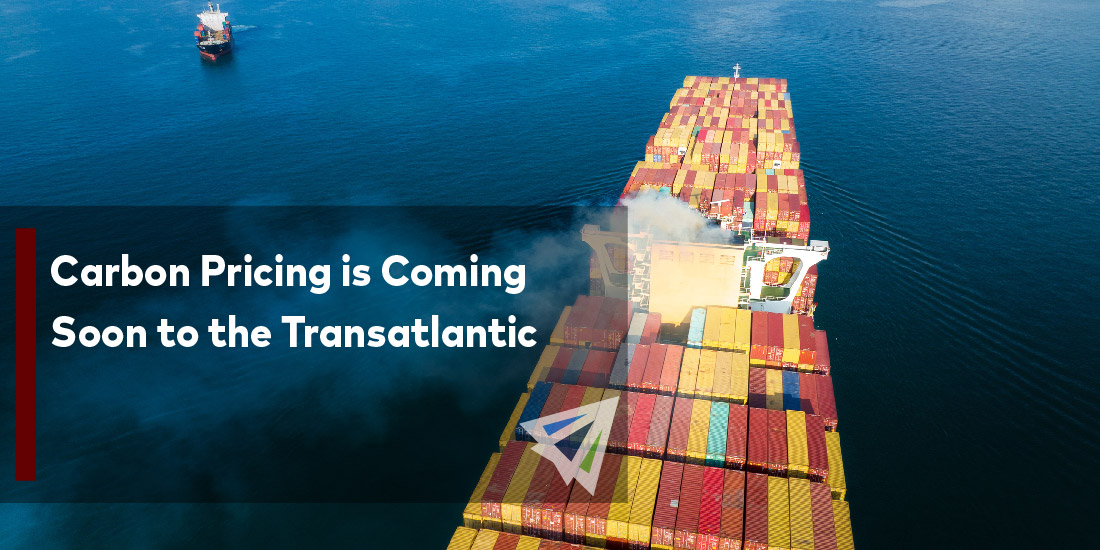With maritime transportation included in the EU Emissions Trading System next year, ocean carriers have released their respective estimates on surcharges, or carbon pricing, for containers bound to and from Europe.
Even a decade ago, carbon neutrality seemed more like a distant whispering, a happy go-lucky ideal. It seemed like there was good faith to turn the page towards greener ways of operating, however nothing in the past can compare to the present day—rapidly evolving standards and expectations for industries to mitigate their carbon footprints.
With a faster pace being set for international trade, not being green (environmentally conscient) with operations may mean losing the other kind of green (money).
EU carbon program in effect January, ocean carriers must comply
This particular development will impact transatlantic trade. The European Union (EU)’s Emissions Trading System will apply to the shipping sector starting January 1.
The EU ETS will operate in only European countries which are members of the EU. Additionally, non-EU countries Iceland, Liechtenstein, and Norway have also committed to ETS.
ETS is essentially a program that charges companies for their respective greenhouse gas emissions. In other words: you’ll pay for what you pollute. The program started in 2005, however 2024 is when it’ll go into effect for maritime transportation.
The EU reasons this program as an incentive to reduce emissions, while also generating revenues to finance the union’s green transition plan.
ETS works on a principle referred to ‘cap and trade’. A cap is a limit set on the total amount of GHG that can be emitted by certain industries, which will now include international shipping, covered by the system. The cap will continue to be reduced annually in line with the EU’s climate target.
This emission cap is expressed in allowances—the right to emit a certain amount of carbon (one allowance equals one ton of carbon dioxide emitted). In return, companies, which will soon be ocean carriers, must be accountable for their emissions and surrender the right number of allowances. A failure to comply will mean heavy fines.
Allowances are available for users to buy on the EU carbon market. Companies can also trade allowances with each other as needed. It’s sort of like hobbyists buying and trading baseball cards, except it’s a bureaucratic trading card game between massive corporate entities and not two retired math teachers.
Carriers announce carbon surcharges ahead of EU ETS
With a brief crash course on the EU ETS behind us, let’s check out how this will impact transatlantic trade in 2024.
Major ocean carriers have acknowledged in advance that their enrollment in ETS will directly impact their 2024 pricing. The following are three carriers and their respective, estimated, carbon pricing.
Note that the following carrier estimated pricing is represented in Euro (€). The adjusted amount in U.S. dollars was cross-referenced by Interlog on October 25. The exchange rate between the two currencies are subject to change over time.
CMA CGM
Earlier this month, the world’s third largest carrier released a customer advisory relating to its estimated pricing.
The French carrier stated that “added costs will include a surcharge applicable for all containers loaded on CMA CGM services impacted by [EU ETS]”.
Per twenty-foot-equivalent unit (TEU), Europe to North America trade lanes will receive a surcharge of €43 ($46 USD) for dry containers and €65 ($69 USD) for refrigerated (reefer) containers.
CMA CGM will initiate these surcharges mid-November and review them on a quarterly basis.
Maersk
The Danish carrier advised on its pricing adjustments back in September. “The cost of compliance is expected to be significant and will keep increasing with the phased implementation.”
The world’s second largest shipping line went on to say, a forwarded fee, referred to as an “Emissions Surcharge”, will be applied on all transits subject to the EU ETS.
Maersk applied its estimated surcharges per forty-foot-equivalent unit (FFE). From North Europe to the U.S., dry container prices will be €81 ($86 USD), while reefers will be €122 ($129 USD).
For U.S. exporters, dry prices will be €58 ($61 USD) and reefers will be €87 ($92 USD) for any outbound cargo to North Europe.
Similarly to CMA CGM, Maersk informed its customers that these emission surcharges will be updated every quarter.
Hapag-Lloyd
The German carrier also released its pricing estimates in September.
Per TEU, North Europe to the U.S. and Canadian East Coast will be €9 ($10 USD) for dry containers and €16 ($17 USD) for reefer containers.
Hapag-Lloyd said shipper-customers using the carrier’s Ship Green service will eligible for varying degrees of credit of the ETS surcharge on freight invoices. This could be 25 percent, 50 percent, or even 100 percent, the carrier noted.
Hapag-Lloyd is currently the world’s fourth largest ocean carrier.
Final Thoughts
The dawn of the EU ETS is yet another reminder that carbon accountability is on the rise in international shipping. This program can certainly be lauded as a well-intended push, albeit maybe a forceful shove, for the industry to reduce emissions, however it’s also an indicator that carbon neutral efforts will come with newfound operational costs—the likes of which will always find their way onto the invoices of shipper-customers.
Should you have any questions regarding this and how it could impact your shipments, please reach out to our team today.
Additionally, we have our weekly market updates with relevant freight news, updates, and developments across the industry.

3 thoughts on “”